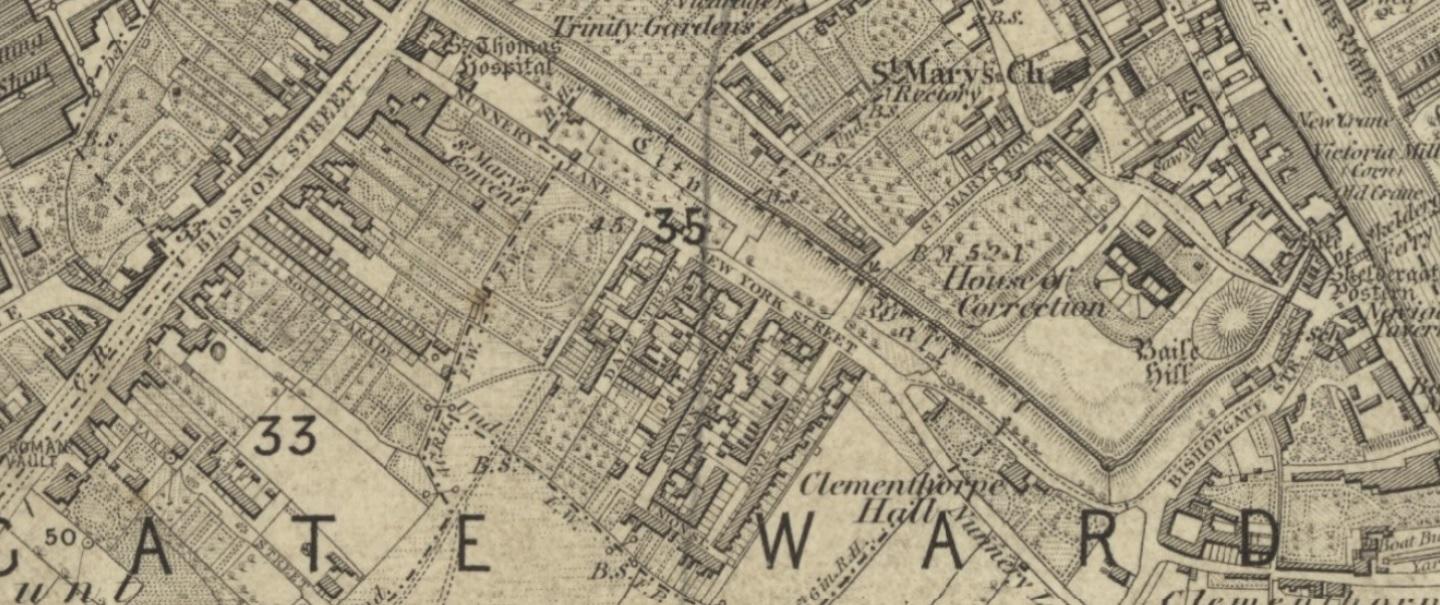14th October 2020
Researching poverty in 1841 in York
On our website here we've been able to keep you in touch with how we've explored aspects of mid-19th century outdoor relief (as opposed to relief in the workhouse), in St Mary Bishophill Junior parish in York.
Today Dick Hunter looks at the background to our research, and cites examples of those who applied for assistance from Dale Street, Dove Street and Swann Street in York.

Extract from map of York showing the parish of St Mary Bishophill Junior, OS six inch map Yorkshire 174 surveyed 1846-51; pub. 1853. See https://maps.nls.uk/view/102344815
Our research has been prompted by a local source, the post-1834 poor law archive at Explore York. This consists of a range of material revealing how welfare was organised. Poor Law archives in the UK and Ireland are dominated by workhouse records. However, most of those who received relief (welfare support) were in the community, and Explore York's collection of out-relief records helps discover their lives.
Relief came in the form of grants, either in kind or money, or a combination of both, which allowed poor people to remain in their own homes. People could be on either temporary relief or permanent relief.
We were fortunate to be trained in use of the records by Dr Kate Gibson, of the University of Manchester. Explore York archivists introduced us to the collection, and prepared a series of useful guides, held in a blue folder at the staff desk in the Search Room. Of particular interest are two sets of records completed by Poor Law Union Relieving Officers (ROs). They assessed applications for relief, recommended any action and paid out-relief to those who were eligible. They reported directly to the Board of Guardians. For more about ROs see our April 2020 blog post Paupers and York Poor Law Union.
The large leather-bound volumes of records of interest are quarterly Application & Report books (A & R) and Outdoor Relief Lists (ORL). A & R books give applicants' details: names of family members, their ages, street, occupations, and marital status. They record if able-bodied, whether relief is received from other sources (e.g. charities), the immediate cause for applying for relief, what relief is awarded (if any) and for what length of time.
Outdoor Relief Lists (ORL) cover half years. They name those in receipt of relief, amounts per quarter, and totals in money and kind for each half year. Statistical columns include gender, marital status, children and vagrants.
The A & R book for the quarter ending September 1841 reveals John Acey (64), 12 Dale Street and married to Mary (68). He had been a gardener but was now totally disabled. She was a washerwoman, partially disabled. They had no income from other sources and were awarded five shillings a week.
Ann Harrison appears in the A & R book for the quarter ending June 1841. She is 21, single, and living in Swann Street with her father. She applies for relief in her confinement, but the award is deferred. She is later given relief on the birth of her 'bastard' son, Joseph, but he dies in infancy.
James Swift (74) and his wife Isabella (69) live in Dale Street and are awarded permanent relief of five shillings a week in 1840.
Hannah Tootle (30) is single, and rents at £5 a year in Dale Street in 1841, with her three 'bastard' children, William (11), Christopher (6) and Lawrence (3). There is some support from the father. It is not clear from the records what relief she is awarded, if any.
Ann Wheeler (32) lodges in Dale Street with her four children, Margaret (14), George (10), Mary Ann (4) and Ellen (2). She is married, but her husband is in an asylum. She receives seven shillings weekly from a friendly society, but applies for poor relief in the quarter ending March 1840. There is no record of the result.
These examples offer a glimpse of the lives of the poor of our parish 180 years ago. Whilst details are sketchy, in some cases they prompt further questions, and encourage exploration.
This blog explores the experiences of the poor between 1833 and 1900, in their own words: https://intheirownwriteblog.
Note
Explore York Archives catalogue references:
Application & Report Books PLU/3/1
Outdoor Relief Lists PLU/3/2



